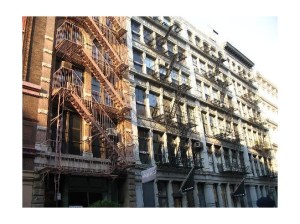
In New York, the commonly accepted wisdom is that art galleries tend to gravitate to gritty up-and-coming areas thick with bohemians, artists and hipster hangers-on. But a new study released by the University of Southern California’s Lusk Center for Real Estate claims just the opposite: Galleries open in high-end Manhattan neighborhoods that house the kind of wealthy consumers likely to buy art, not the people making it.
“These findings counter the common and somewhat romantic perception that galleries locate in gritty artist communities,” assistant professor Jenny Schuetz, who co-authored the study with Lusk Director Richard Green, wrote. “Similar to jewelry, furniture and antique districts, most galleries cluster near affluent potential art buyers, rather than the artists themselves.”
The neighborhood profile that attracts art galleries, the study asserts, “is consistent with luxury retail.”
How could we have been so wrong-headed about the relationship between art galleries and real estate all these years? The answer is that we weren’t.
Though the study boasts data from a time span of more than 40 years (starting in 1970), from which the authors analyzed data on the location of Manhattan art galleries, it fails to look at the role that early galleries played in neighborhood change and development, and the difference between those early galleries and later ones eager to open in areas with an established reputation, focusing instead on sheer totals. This is no small oversight given that the impact of pioneering galleries is often pivotal, unlike Johnny-come-latelies.
“Galleries appear to be less interested in locating near starving artists than in being near one another and near potential art collectors,” the study claims. But while art galleries tend to cluster together, they usually do so in up-and-coming neighborhoods where the first steps toward gentrification have already been taken by resident artists. Artists who, while they may be starving, usually differ from their working-class neighbors when it comes to education, family background and economic and social mobility.
The study’s authors, based on the current profile of Soho and Chelsea, as well as the Upper East Side and West 57th Street, claim that these places share the same characteristics as luxury shopping districts given that they have an affluent, educated, largely white population, but in the years that they first became known as gallery districts the neighborhoods were more low-rent than luxury.
While the study acknowledges that some well-known dealers started opening galleries in Soho in the early 1970s and that the number of galleries in Soho increased more than tenfold, from 5 to 58 between 1970 and 1975, they do not acknowledge that the Soho of that era was a rough-and-tumble place with few amenities rather than a district favored by the rich and powerful. This early era was potentially, even likely, to have been more important in the neighborhood’s destination as a gallery district than the 15 years that followed, when the number of galleries quadrupled before falling sharply between 1995 and 2003. Nor do they consider that the late-on-the-scene galleries may have been risk-averse, attracted to a seemingly sure thing rather than trying to woo wealthy buyers on their home turf.
This is further borne out by the story of galleries in Chelsea. The neighborhood had a small number of galleries throughout its less prosperous years—13 in 1975, 34 in 1995 and then a huge boom between 1995 and 1997, doubling to 67 that year and then leaping to 133 in 1999 before peaking at 201 in 2002. Like Soho, the first galleries, the trendsetters, the ones who established Chelsea as a gallery district, opened up in the lean rather than fat years, only to be followed by scores of copycats once the neighborhood’s path was set.
Perhaps most importantly, the number of galleries in both Soho and Chelsea decreased sharply as those neighborhoods became wealthier. In 2003, the number of galleries in Chelsea decreased from 201 to 176. While some closures might be attributed to oversaturation of the market, it seems likely that galleries were chased out by rising rents, a factor that their owners often cited as a reason for relocation.
Artists are some of the first harbingers of neighborhood change and, once they have established a presence, are often followed by galleries whose role, after all, is to act as a bridge between the artists and the generally wealthy collectors who wish to buy their work. It is these bohemian neighborhoods where art galleries tend to clump, rather than in established, wealthy neighborhoods. In this sense, the dichotomy between bourgeois and bohemian is pointless. Galleries must navigate between those two worlds as a matter of existence, a delicate balance which their choice of location often highlights.
This is why new galleries are now opening on the Lower East Side, Bushwick and, to a lesser extent, Hell’s Kitchen. Galleries don’t seek out luxury districts but rather help create them, accelerating the transformation of neighborhoods that are already changing. If they sought out the highest concentrations of wealthy buyers, we would be seeing a spate of gallery openings in Tribeca or the Upper West Side instead of the Lower East Side and Bushwick, neighborhoods that may well, in the coming years, start to bear all the classic hallmarks of luxury shopping districts, at which point the galleries that helped transform them will start to move on.

